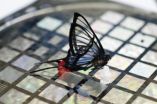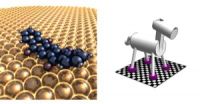Wildflower 'armors' itself against disease
2010-09-13
(Press-News.org) An unusual wildflower that accumulates metals in its leaves has been found to use them as a kind of 'armor' against bacterial infection. Scientists from Oxford University have shown that when Alpine pennycress (Thlaspi caerulescens) plants accumulate metals in their leaves, they become resistant to attack by the bacterium Pseudomonas syringae pv. maculicola. They report their findings September 9 in the open-access journal PLoS Pathogens.
Thlaspi, a small plant in the mustard family that grows on metal-rich soils scattered around Britain and Europe, such as the sites of former mine workings, is known to accumulate zinc, nickel and cadmium to very high concentrations in its leaves. "
Our results demonstrate that these plants are exploiting their metal-rich environment to armor themselves against disease," said co-author Dr Gail Preston of Oxford University's Department of Plant Sciences, co-author of the report. "What we've found is a direct link between these high metal concentrations and resistance to bacterial infection."
Co-author Helen Fones cultivated Thlaspi plants on progressively higher concentrations of zinc, nickel and cadmium and showed that all three metals were able to defend the plant against the pathogenic bacterium. By studying diverse strains of the bacterium, she was able to demonstrate a close relationship between the ability of bacteria to grow in the presence of high concentrations of metal and their ability to infect the plants.
"Previously, it has been difficult to explain why Thlaspi plants should accumulate such high concentrations of potentially toxic metals," said co-author Professor Andrew Smith of Oxford's Department of Plant Sciences, co-supervisor of the research. "Our findings provide good evidence that, by accumulating metals, these plants benefit from enhanced protection against enemies such as pathogenic microorganisms and herbivores."
The researchers also showed that bacteria surviving on Thlaspi plants on the site of a former lead–zinc mine in Wales had a higher tolerance for zinc than bacteria isolated from plants growing on normal soils. This indicates that both the plant and its pathogens show evidence of local adaptation to survival in metal-rich environments, and that pathogens can adapt to overcome plant defenses based on metals.
"Heavy metals may be part of an evolutionary 'arms race' between plants and the microorganisms that try to colonize them," said Dr. Preston.
###
FINANCIAL DISCLOSURE: This work was supported by a graduate studentship awarded to HF by the Natural Environment Research Council, and by grants from the Society for General Microbiology and the British Society for Plant Pathology. GMP was supported by a Royal Society University Research Fellowship. The funders had no role in study design, data collection and analysis, decision to publish, or preparation of the manuscript.
COMPETING INTERESTS: The authors have declared that no competing interests exist.
PLEASE ADD THIS LINK TO THE PUBLISHED ARTICLE IN ONLINE VERSIONS OF YOUR REPORT: http://dx.plos.org/10.1371/journal.ppat.1001093
CITATION: Fones H, Davis CAR, Rico A, Fang F, Smith JAC, et al. (2010) Metal Hyperaccumulation Armors Plants against Disease. PLoS Pathog 6(9): e1001093. doi:10.1371/journal.ppat.1001093
Disclaimer
This press release refers to an upcoming article in PLoS Pathogens. The release is provided by the article authors and their institution. Any opinions expressed in these releases or articles are the personal views of the journal staff and/or article contributors, and do not necessarily represent the views or policies of PLoS. PLoS expressly disclaims any and all warranties and liability in connection with the information found in the releases and articles and your use of such information.
Media Permissions
PLoS Journals publish under a Creative Commons Attribution License (http://creativecommons.org/licenses/by/2.5/), which permits free reuse of all materials published with the article, so long as the work is cited (e.g., Kaltenbach LS et al. (2007) Huntingtin Interacting Proteins Are Genetic Modifiers of Neurodegeneration. PLoS Genet 3(5): e82. doi:10.1371/journal.pgen.0030082). No prior permission is required from the authors or publisher. For queries about the license, please contact the relative journal contact indicated here: http://www.plos.org/journals/embargopolicy.php
About PLoS Pathogens
PLoS Pathogens (www.plospathogens.org) publishes outstanding original articles that significantly advance the understanding of pathogens and how they interact with their host organisms. All works published in PLoS Pathogens are open access. Everything is immediately available subject only to the condition that the original authorship and source are properly attributed. Copyright is retained by the authors. The Public Library of Science uses the Creative Commons Attribution License.
About the Public Library of Science
The Public Library of Science (PLoS) is a non-profit organization of scientists and physicians committed to making the world's scientific and medical literature a freely available public resource. For more information, visit http://www.plos.org.
END
ELSE PRESS RELEASES FROM THIS DATE:
2010-09-13
VIDEO:
Artificial skin for people and robots could be a reality using the ultra-sensitive sensors developed by Zhenan Bao, associate professor of chemical engineering at Stanford University, and her team. The...
Click here for more information.
The light, tickling tread of a pesky fly landing on your face may strike most of us as one of the most aggravating of life's small annoyances. But for scientists working to develop pressure sensors for artificial skin for use on ...
2010-09-13
RIVERSIDE, Calif. – Molecular machines can be found everywhere in nature, for example, transporting proteins through cells and aiding metabolism. To develop artificial molecular machines, scientists need to understand the rules that govern mechanics at the molecular or nanometer scale (a nanometer is a billionth of a meter).
To address this challenge, a research team at the University of California, Riverside studied a class of molecular machines that 'walk' across a flat metal surface. They considered both bipedal machines that walk on two 'legs' and quadrupedal ones ...
2010-09-13
(NEW YORK, NY, September 13, 2010) – A new study led by researchers at Columbia University Medical Center has identified a novel molecular pathway underlying Parkinson's disease and points to existing drugs which may be able to slow progression of the disease.
The pathway involved proteins – known as polyamines – that were found to be responsible for the increase in build-up of other toxic proteins in neurons, which causes the neurons to malfunction and, eventually, die. Though high levels of polyamines have been found previously in patients with Parkinson's, the new ...
2010-09-13
Durham, NH—September 13, 2010— During the recent recession in the United States, many industries suffered significant layoffs, leaving individuals and families to revise their spending and rethink income opportunities. Many wives are increasingly becoming primary breadwinners or entering the labor market. A new article in Family Relations tests "the added worker" theory, which suggests wives who are not working may seek work as a substitute for husband's labor if he becomes unemployed, and finds that during a time of economic downturn wives are more likely to enter the ...
2010-09-13
VIDEO:
Years of research has proven that saturated and trans fats clog arteries, make it tough for the heart to pump and are not valuable components of any diet. Unfortunately, they...
Click here for more information.
COLUMBIA, Mo. ¬— Years of research has proven that saturated and trans fats clog arteries, make it tough for the heart to pump and are not valuable components of any diet. Unfortunately, they are contained in many foods. Now, a University of Missouri research ...
2010-09-13
Montreal / September 13, 2010 – September 21, 2010 marks the one year anniversary of the release of a landmark document produced by researchers at Concordia University. Mobilizing The Will to Intervene (W2I) offers governments practical steps to prevent future genocides and mass atrocities. Produced by researchers with the Montreal Institute for Genocide and Human Rights Studies (MIGS) based at Concordia, the document was presented to the governments of Canada and The United States of America. It has already yielded concrete results.
Under President Barack Obama's leadership, ...
2010-09-13
The National Institute on Drug Abuse (NIDA), part of the National Institutes of Health, announced today that Dr. Eric M. Verdin of the J. David Gladstone Institutes in San Francisco, Calif., has been selected as the 2010 recipient of the NIDA Avant-Garde Award for HIV/AIDS Research for his proposal to study the mechanisms of latent HIV infection. NIDA's annual Avant-Garde award competition, now in its third year, is intended to stimulate high-impact research that may lead to groundbreaking opportunities for the prevention and treatment of HIV/AIDS in drug abusers. Awardees ...
2010-09-13
WASHINGTON — A new look at tests of mental aging reveals a good news-bad news situation. The bad news is all mental abilities appear to decline with age, to varying degrees. The good news is the drops are not as steep as some research showed, according to a study published by the American Psychological Association.
"There is now convincing evidence that even vocabulary knowledge and what's called crystallized intelligence decline at older ages," said study author Timothy Salthouse, PhD.
Longitudinal test scores look good in part because repeat test-takers grow familiar ...
2010-09-13
Scientists at Emory University School of Medicine have uncovered how a structural component inside neurons performs two coordinated dance moves when the connections between neurons are strengthened.
The results are published online in the journal Nature Neuroscience, and will appear in a future print issue.
In experiments with neurons in culture, the researchers can distinguish two separate steps during long-term potentiation, an enhancement of communication between neurons thought to lie behind learning and memory. Both steps involve the remodeling of the internal ...
2010-09-13
A new University of Colorado at Boulder study sheds light on the brain mechanisms that allow us to make choices and ultimately could be helpful in improving treatments for the millions of people who suffer from the effects of anxiety disorders.
In the study, CU-Boulder psychology Professor Yuko Munakata and her research colleagues found that "neural inhibition," a process that occurs when one nerve cell suppresses activity in another, is a critical aspect in our ability to make choices.
"The breakthrough here is that this helps us clarify the question of what is happening ...
LAST 30 PRESS RELEASES:
[Press-News.org] Wildflower 'armors' itself against disease


